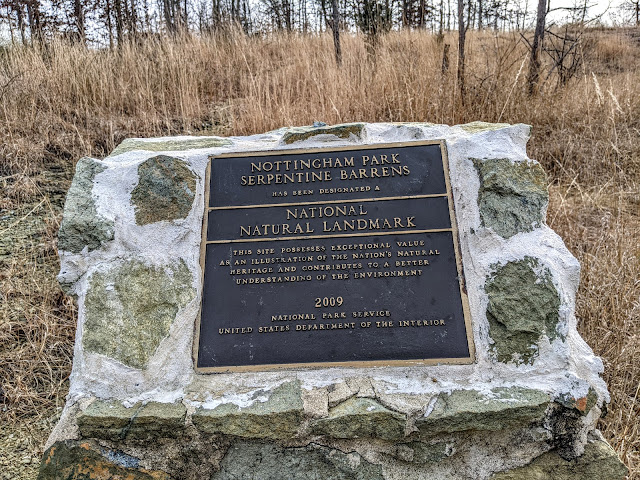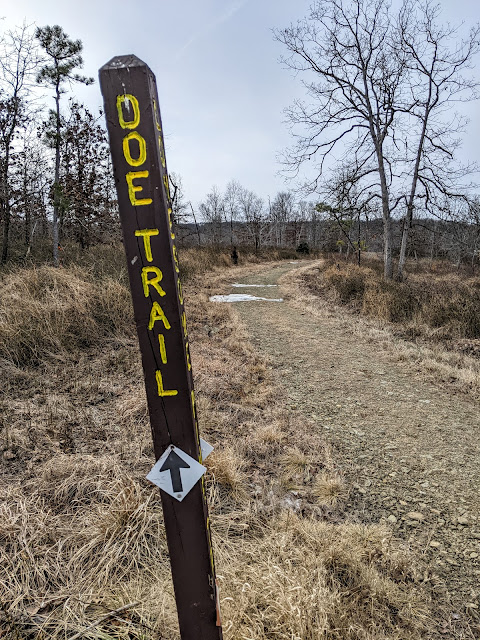Hike #2 of my 2022/52 Hike Challenge happened at Nottingham County Park in Chester County, PA, on one of the coldest days of the New Year so far. I was layered up fine but I was a little worried about short-haired ole' Amos but he did great - as long as we were moving. He did not like to stand still very long, even for a quick snap for a picture. A fast five miles over some rough roads kept us both warm.
 |
| Landmark |
I've hiked here before but usually when things are greened up and the rare chromium barrens plants can be found. Today though, was a special kind of bleak. Even so, the barrens prairie grasses bathed the hills in gold. The trails were iced over in many places but easily gotten around. Only one other (very cold) hiker was out today and by the sound of her hacking cough, was not someone I did not want to get too close to. I'm trying to avoid people and not get sick as I await the arrival of my grandson Sawyer, due anytime now. Please lady, don't ask to pet Amos...
 |
| Doe, Feldspar, and Buck Trails make for 5 miles. |
But she did. I had to explain to her that I am trying to avoid close contact so that I can meet my new grandson. She was kind enough, even though hacking away with red eyes and runny nose, to wave okay and we went our opposite ways. I must admit that I have lost any shred of patience with how people are treating this latest turn of the Covid pandemic. To avoid any bitterness, I tried to distract myself as she hiked away and admired the hard work the park staff have put into repairing the old roads that have washed out repeatedly with our many torrential rainfalls this past year. It seems like a never ending job at one culvert in particular and it seems it is always washed out. The large flakes of serpentine rock were thrown from the flooded culvert bank into the path. Ravine-like gullies run like giant sword slashes from uphill to downhill. An old cement culvert pipe sits broken and battered on the edge of the stream. All around are tractor tracks and boot prints pressed into the frozen mud.
 |
| An almost completed Figure-8 for five miles |
Barrens habitats are rare in the Mid-Atlantic, but extra rare everywhere else. They harken back to the thousands of years of cold savanna that once covered the state after the recession of ice sheets, but these barrens are the result of heavy metal soils where only special plants can handle the mineral and environmental stress. The work it takes the park to keep these short grass prairies from being overrun with greenbriar and pine woods is never-ending. Managed by fire as far back as the Early Woodland Period (1000
BC - 1500
AD)
these vast chromium hills were the much more extensive. Agriculture has carved them up and fire management practices once so important to indigenous peoples were long forgotten. Not until the 1980s when modern conservation re-discovered the use of fire to maintain important habitat for threatened plants, insects, and animals, did the practice return to this area.
 |
| Staghorn Sumac - an important winter food for birds |
I felt guilty every time we rounded a bend only to scare dozens of birds off abundant staghorn sumac stands. With the ground now frozen solid, birds are unable to scratch the earth for seeds and wintering insects so they rely heavily on dried seeds and fruits clinging to bushes and vines. All the Poison Ivy berries have been picked over. The delicate Black Birch fruits might still contain some small winged oil seeds but are mostly gone. I spotted a flock of Robins working over a small holly tree and near that, a small winterberry. We rounded another bend and frightened off a small hawk that had hunted and killed a songbird. Amos stopped to inspect the pile of feathers, likely a Towhee.
 |
| Eastern White Pine |
 |
| Eastern Red Cedar |
 |
| Black Birch |
Adding to the bleakness of the scenery, I observed nearly all the Pitch Pines were dead as compared to a few years ago (2017) when I did this hike in the early fall and made note of how stressed these trees seemed to be. The Southern Pine Bark Beetle has ravaged the Pitch Pines. White Pines seemed to be holding their own. But but at every major trail intersection there were log landings where forestry crews felled, piled, and de-barked the salvaged trees for lumber. This is a win-some/lose-some situation though, as the freshly opened landscape will quickly recover in native grasses and even in the heavy equipment scars, the grasses and rare plants will soon appear. Soil disturbance is one technique for managing barrens habitats, so it seems the bark beetle has helped manage the invading forest.
 |
| Grasslands minus the once prevalent Pitch Pine |
We circled the old quarry holes and were startled by a flock of Turkeys flying low to land in a stand of Scrub Oak. I swear, the sight and sound of wild turkeys coming in to roost is something like watching a freight train in flight. The sound of the crashing turkeys spooked a herd of twenty deer that bolted across the stony road in front of Amos who of course had to holler full-throat at them which in turn scared the turkeys who took off for another roost. The whole time, a Great Blue Heron stood resolutely on a maple knoll inside the flooded quarry hole. He or she must have felt safe on the inside of the chain link fence as compared to what was going on outside of it!
 |
| One of two flooded quarries to be passed on the Feldspar Trail |
The uphill frozen road with its jagged, flood-washed slabs of sharp rock and large patches of thick ice made for a slow slog. This section generated some heat and by the time we'd reached the top I was unzipping my jacket and pulling off my mittens. But the sharp wind soon had me zipping back up. The high for today was 16 degrees and who knows what the wind chill was. I breathed it in until my lungs ached with cold, cold air, which I am so grateful for. Down in the hollow crossing a creek near the quarry holes, the air was impossibly still. Here on the height of the barrens, it pushed me along and Amos, sensing my pace had quickened, decided to pull. The wind at my back, the coonhound in front straining against his rope, we jogged the whole way back to the trail intersection where come summer the rare Pinks, Asters, and Oxeyes will bloom in the ruts of the logging trucks.
 |
| Victory Run - no wind. |
 |
| On the hilltops - big wind. |
As we cruised down the trail towards the parking area, I stopped to look back at one of the few views where pines still painted a swath of green across the brown and gold grasslands. White Pines stood higher and filled in some of the gaps where gnarled Pitch Pines once stood like a wall of twisted trunks and gnarled branches. The White Pine stood tall, straight, dignified and maybe even defiant. I stopped at a dying Pitch Pine and pushed my pinky into a bark beetle hole. Warmer winters and hotter summers have allowed this beetle to decimate this pine forest, but were it not for the ravages of the beetle the Bluestem grasslands would not have expanded as they have. The look-back view was astounding in its width and breadth of native grasses in winter gold across the hills.
 |
| Dying Pitch Pine with Bark Beetle holes in a red trail blaze |
Notes:
Nottingham County Park (Chester County Parks) https://www.chesco.org/4626/Nottingham-Park
Stateline Serpentine Barrens, Nature Conservancy: https://www.nature.org/en-us/get-involved/how-to-help/places-we-protect/state-line-serpentine-barrens/
"The Aftermath of the Southern Pine Bark Beetle at Nottingham" (2019) https://www.brandywine.org/conservancy/blog/history-and-aftermath-southern-pine-bark-beetle-nottingham-county-park
































